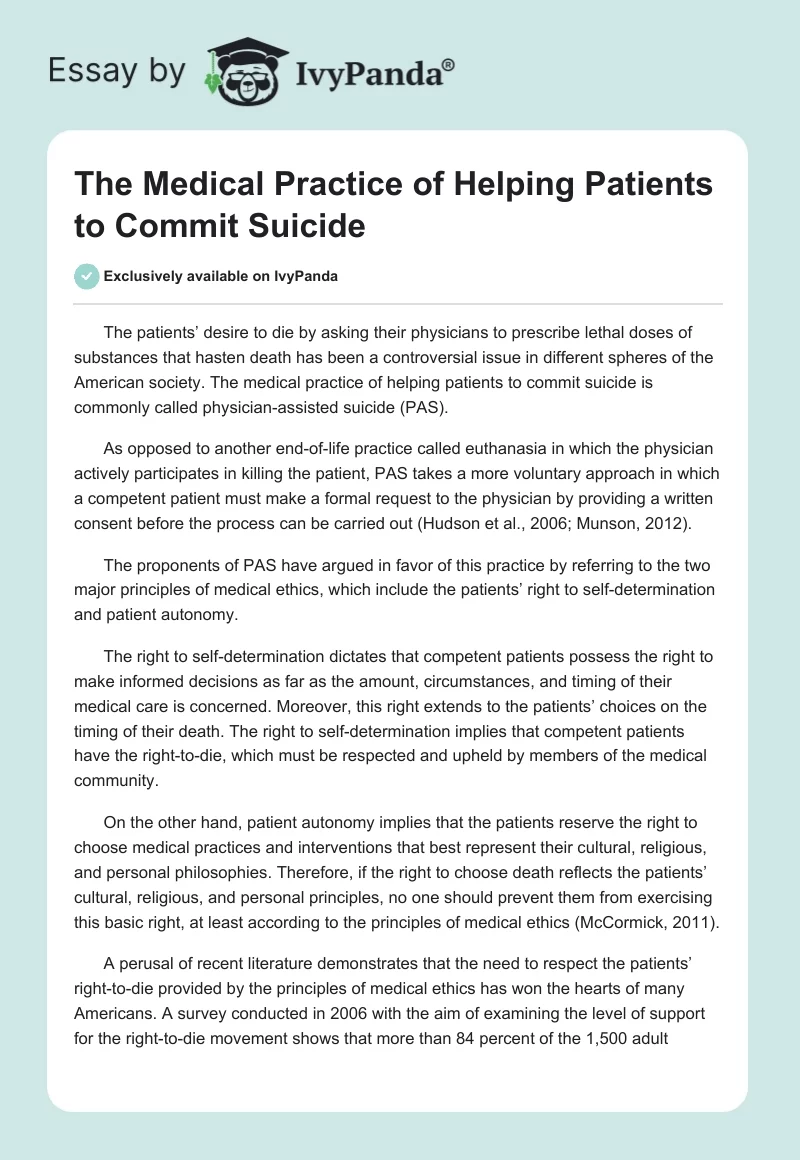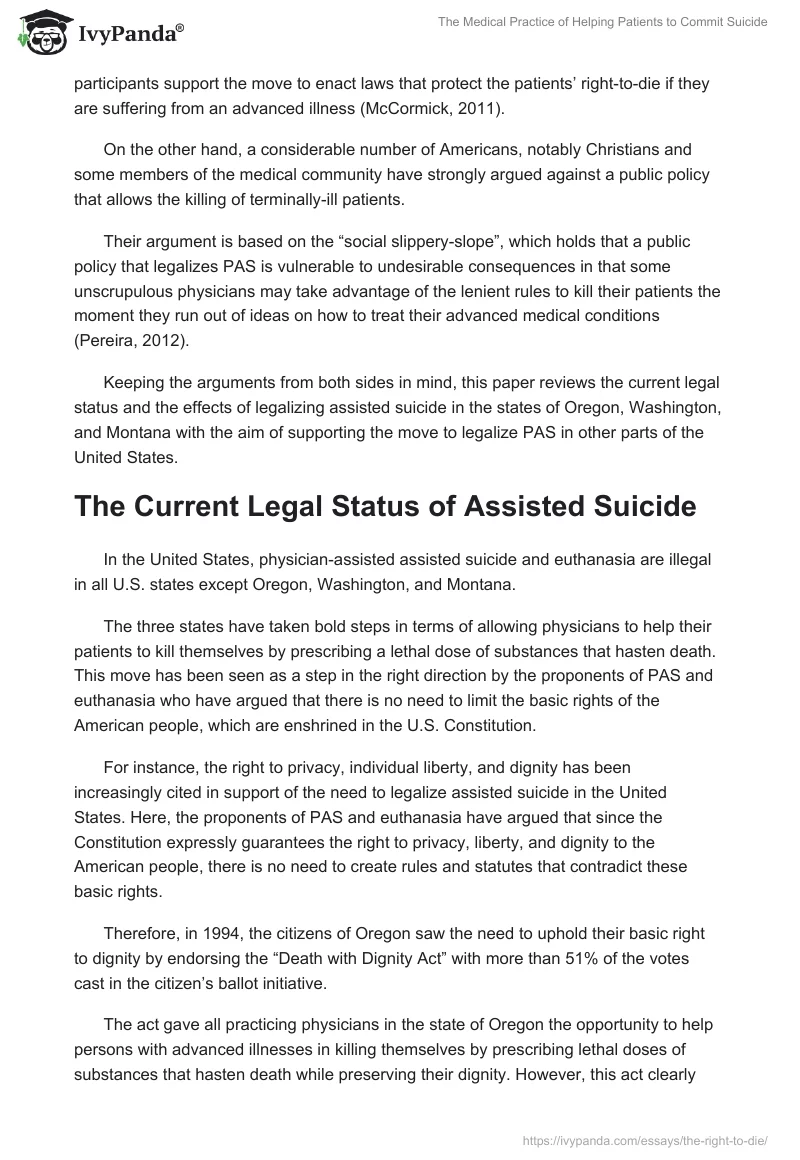The patients’ desire to die by asking their physicians to prescribe lethal doses of substances that hasten death has been a controversial issue in different spheres of the American society. The medical practice of helping patients to commit suicide is commonly called physician-assisted suicide (PAS).
As opposed to another end-of-life practice called euthanasia in which the physician actively participates in killing the patient, PAS takes a more voluntary approach in which a competent patient must make a formal request to the physician by providing a written consent before the process can be carried out (Hudson et al., 2006; Munson, 2012).
The proponents of PAS have argued in favor of this practice by referring to the two major principles of medical ethics, which include the patients’ right to self-determination and patient autonomy.
The right to self-determination dictates that competent patients possess the right to make informed decisions as far as the amount, circumstances, and timing of their medical care is concerned. Moreover, this right extends to the patients’ choices on the timing of their death. The right to self-determination implies that competent patients have the right-to-die, which must be respected and upheld by members of the medical community.
On the other hand, patient autonomy implies that the patients reserve the right to choose medical practices and interventions that best represent their cultural, religious, and personal philosophies. Therefore, if the right to choose death reflects the patients’ cultural, religious, and personal principles, no one should prevent them from exercising this basic right, at least according to the principles of medical ethics (McCormick, 2011).
A perusal of recent literature demonstrates that the need to respect the patients’ right-to-die provided by the principles of medical ethics has won the hearts of many Americans. A survey conducted in 2006 with the aim of examining the level of support for the right-to-die movement shows that more than 84 percent of the 1,500 adult participants support the move to enact laws that protect the patients’ right-to-die if they are suffering from an advanced illness (McCormick, 2011).
On the other hand, a considerable number of Americans, notably Christians and some members of the medical community have strongly argued against a public policy that allows the killing of terminally-ill patients.
Their argument is based on the “social slippery-slope”, which holds that a public policy that legalizes PAS is vulnerable to undesirable consequences in that some unscrupulous physicians may take advantage of the lenient rules to kill their patients the moment they run out of ideas on how to treat their advanced medical conditions (Pereira, 2012).
Keeping the arguments from both sides in mind, this paper reviews the current legal status and the effects of legalizing assisted suicide in the states of Oregon, Washington, and Montana with the aim of supporting the move to legalize PAS in other parts of the United States.
The Current Legal Status of Assisted Suicide
In the United States, physician-assisted assisted suicide and euthanasia are illegal in all U.S. states except Oregon, Washington, and Montana.
The three states have taken bold steps in terms of allowing physicians to help their patients to kill themselves by prescribing a lethal dose of substances that hasten death. This move has been seen as a step in the right direction by the proponents of PAS and euthanasia who have argued that there is no need to limit the basic rights of the American people, which are enshrined in the U.S. Constitution.
For instance, the right to privacy, individual liberty, and dignity has been increasingly cited in support of the need to legalize assisted suicide in the United States. Here, the proponents of PAS and euthanasia have argued that since the Constitution expressly guarantees the right to privacy, liberty, and dignity to the American people, there is no need to create rules and statutes that contradict these basic rights.
Therefore, in 1994, the citizens of Oregon saw the need to uphold their basic right to dignity by endorsing the “Death with Dignity Act” with more than 51% of the votes cast in the citizen’s ballot initiative.
The act gave all practicing physicians in the state of Oregon the opportunity to help persons with advanced illnesses in killing themselves by prescribing lethal doses of substances that hasten death while preserving their dignity. However, this act clearly states that a person seeking assisted suicide must be ailing from an illness that limits his or her life expectancy to a period of less than six months (Munson, 2012).
Despite the citizens’ majority endorsement of the act, its implementation was delayed due to legal challenges and court cases until 1997 when more than 60% of the voters turned down the move to repeal the act. As a result, the Death with Dignity Act was enacted later in 1997, and Oregon became the only U.S. state to legalize assisted suicide (Munson, 2012).
Despite failed attempts to legalize assisted suicide in different U.S. states, the state of Washington became the second state after Oregon to enact laws that legalize assisted suicide.
In the 2008 citizens’ Ballot Initiative 1000, voters in the state of Washington enacted laws legalizing assisted suicide by 58% of the votes cast. The laws passed in Washington were similar to those found in Oregon’s Death with Dignity Act except that the citizens of Washington preferred the terms, “hastened death” and “aid-in-dying” in the place of “physician-assisted suicide”.
Therefore, in the state of Washington, practicing physicians are permitted by law to prescribe lethal doses of medications that hasten death to their patients. However, for a patient to qualify for hastened death he or she must be an adult of 18 years and above suffering from a terminal illness that limits the life expectancy to less than six months (Munson, 2012).
Apart from Oregon and Washington, reports show that the Supreme Court in the state of Montana ruled that physician-assisted suicide is legal in a court decision issued in 2009. This makes Montana the third U.S. state to legalize PAS. In delivering the court decision for Baxter v. Montana, the justices argued that the patients’ decision to seek assisted suicide does not threaten public peace since it involves a private and compassionate agreement between the patient and the physician.
Moreover, the court’s majority noted that the physician and the patient must be actively involved in creating the necessary means through which the patient must make a private decision on his or her own mortality. This implies that the patient’s private decision is not in any way a threat to public peace and other innocent people.
However, the court’s decision did not decide on whether the people of Montana have a constitutional right to seek assisted suicide by claiming the constitutional provisions that guarantee the right to privacy and dignity. Nonetheless, it is not yet clear whether PAS is legal in Montana since recent reports show that the bill enacted by the state legislature in 2010 was rejected by Montana’s Senate Judiciary Committee (Pereira, 2012).
Safeguarding Assisted Suicide
In the process of upholding the patients’ right to die as described in the laws enacted in the states of Oregon, Washington, and Montana, the framers did not overlook the possibility that some unscrupulous physicians can take advantage of the lenient laws to advance their undesirable practices. As a result, there are many effective safeguards protecting innocent people from various undesirable consequences of legalized assisted suicide.
First, the laws legalizing assisted suicide dictate that all requests for PAS must be voluntary in that the patient must provide a well-considered and informed consent to the physician before the process can be carried out. Precisely, the laws direct that the patients must provide at least three types of requests (two oral and one written) to the physician in the presence of at least two witnesses before the physician prescribes a lethal dose of a substance that hastens death.
Second, it is a legal requirement that the prescribing physicians can only carry out assisted suicide after seeking second opinion and lengthy consultations with another practicing physician. This enables the prescribing physician to confirm the patient’s claim on his or her terminal diagnosis and prognosis, the patient’s level of mental competence, and the patient’s ability to make informed decisions (Munson, 2012; Pereira, 2012).
Another important safeguard entails the requirement that the prescribing physician must inform all the patients requesting assisted suicide about the availability of alternative ways of managing their advanced illnesses including hospice and palliative care services. This information is very useful to the patients since it allows them to make informed decisions before undertaking assisted suicide.
Furthermore, the laws legalizing assisted suicide require that the persons permitted to prescribe the lethal doses of medications that hasten death must be practicing physicians. This eliminates the possibility that unauthorized people will be involved in carrying out such a delicate procedure. Finally, the laws dictate that all cases of assisted suicide must be reported to the relevant authorities for record-keeping and regulation.
The Effects of Assisted Suicide
A perusal of data on assisted suicide since Oregon enacted its laws in 1998 to date shows that there is no significant increase in the rate of mortality in the states where PAS is legal. Studies indicate that 129 people died in 1997 to 2002 after ingesting a lethal dose of a substance that hastens death prescribed by physicians in the state of Oregon. Overall, the number of deaths as a result of assisted suicide has remained slightly below 0.1% of all the deaths that have occurred in the state of Oregon since 1997 to date.
On the other hand, statistics show that 36 people have died as a result of physician-assisted suicide in the state of Washington since the law was passed in 2008. Further, due to the on-going confusion about the legal status of assisted suicide in Montana, there are no reliable statistics showing the number of people who have died as a result of PAS (Munson, 2012).
Generally, the number of people dying as a result of assisted suicide does not reflect the general assumption that legalization of PAS leads to a “slippery slope” whereby physicians will begin to kill their patients indiscriminately.
But instead, the legalization of PAS in the states of Oregon and Washington has seen significant improvements in the way physicians offer end-of-life care to their patients. For example, in the state of Oregon, studies show that after the laws legalizing assisted suicide were passed, most physicians increased the use of morphine for pain management by 50% in 1997-2000.
Further, the number of hospital referrals increased by 30% while the use of pain medications in the end-of-life care increased by 76% at around the same period. Therefore, it is safe to conclude that the other U.S. states are wrong in believing that the legalization of PAS will cause many undesirable consequences such as the indiscriminate killing of terminally-ill patients.
References
Hudson, P. L., et al. (2006). Desire for hastened death in patients with advanced disease and the evidence base of clinical guidelines: A systematic review. Palliative Medicine, 20, 693-701.
McCormick, A. J. (2011). Self-determination, right to die, and culture: A literature review. Social Work, 56(2), 119-128.
Munson, R. (2012). Intervention and reflection: Basic issues in medical ethics (9th ed.). Belmont, CA: Wadsworth Publishing Company.
Pereira, J. (2012). Legalizing euthanasia or assisted suicide: The illusion of safeguards and controls. Curr Oncol., 18(2), 38-45.


